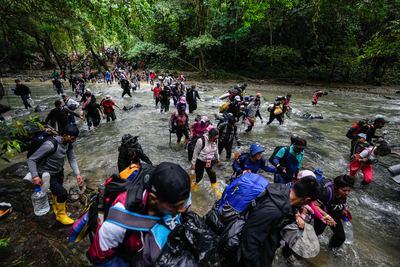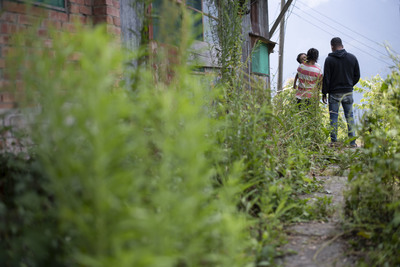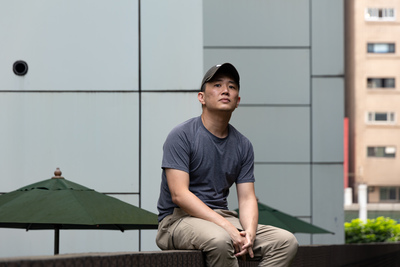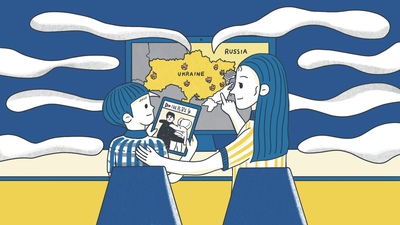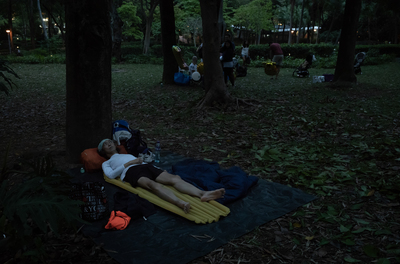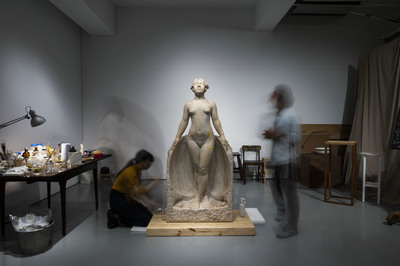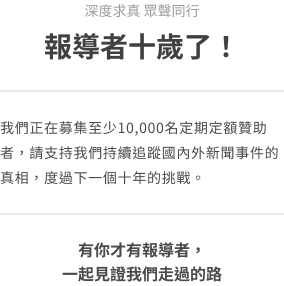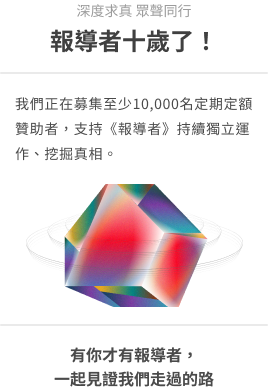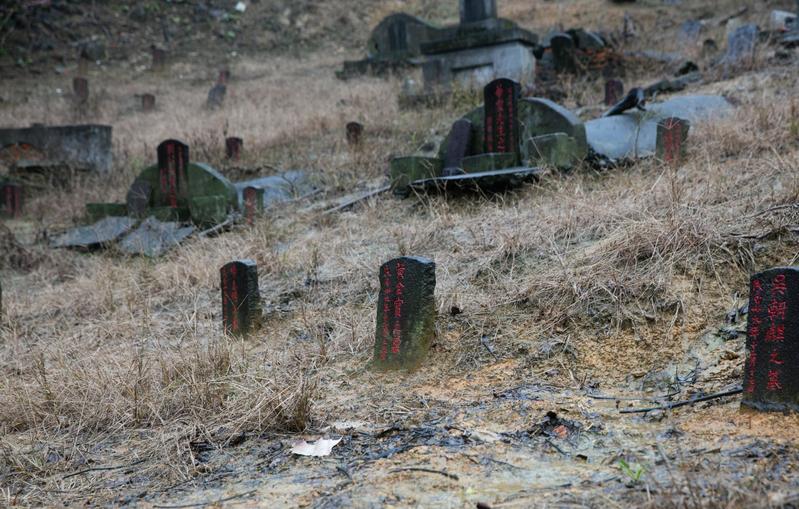
Scattered on the slopes of a public cemetery on the outskirts of Taipei lie the graves of hundreds victims of the White Terror. Forgotten until their discovery in the 1990s, they laid in silence until 2015, when a public debate erupted over their value and whether they were worth preserving.
Lee Kun-long (李坤龍) opens a small door in the wall, sitting inside is a wooden box giving off a melancholy luster in the dim rays of light.
He stands in front, gaze fixed forward, and puts his hands together in prayer, bowing again and again, the faint sound of his low murmurs dissolving into the ambient silence. He takes out a tape to measure the box: "34 centimeters long, 19 wide, 17 high," and records the figures in a notebook. A piece of scrap paper has been taped to the top of the wooden box, and the name Hou Wen-li (侯文理) is written on it.
"Toh (卓仔), I'm worried that there might be nothing inside. It's happened in the past that families take these home and find them empty." Lee directs these words towards the Taipei Mortuary Services Office's columbarium manager, who is tasked with managing the thousands of funerary urns on municipal cemetery lands.
"Do you want me to open it?" Toh raised the wooden box to his ear and gave it a shake. "There's something in there, but not much, most likely some small bones. These kinds of bone urns are not common in Taiwan anymore."
The columbarium — a kind of funerary urn vault — is located in Taipei's Liuzhangli neighbourhood, in the Martial Law Era Victims Memorial Park. It holds bone urns from that era, with more unclaimed remains scattered throughout three sections of the surrounding cemetery.
These small tombstones have been hidden in the depths of history for decades and were only re-discovered in 1993 by the "Mutual Assistance Association for Former Political Prisoners in the Taiwan Area" — a pro-unification group that advocates for greater recognition of the suffering of pro-CCP political victims and their families during Taiwan's White Terror period.
Of the dead who are buried here, 42 percent are bensheng – those who came to Taiwan before World War II – and 58 percent are waisheng – people who fled from China with the KMT. The bensheng families are often too poor to claim these remains, while the waisheng buried here often have no family in Taiwan at all.
According to records, Hou Wen-li was a special agent for the Chinese Communist Party (CCP) who infiltrated the Counterintelligence Bureau of the Ministry of Defense (now the Military Intelligence Bureau) in 1952. He gathered intelligence as the second-in-command of the third column of the Anti-Communist Commando Army before he was executed in 1958. His only known remains were kept in this wooden box for over half a century.
But in 2014, Hou's relatives in eastern China's Jiangsu province found Lee Kun-long, the secretary of the "Taiwan Area Martial Law Political Incidents Management Association". Lee has been at work for a month on Hou's case; once he receives a proof of kinship from China, he can help Hou's relatives come to Taiwan and take the bones of their family member home.
Lee has already lost count of how many people he has helped. For the past 20 years, he has worked in official and unofficial capacities to find a way home for the dead.
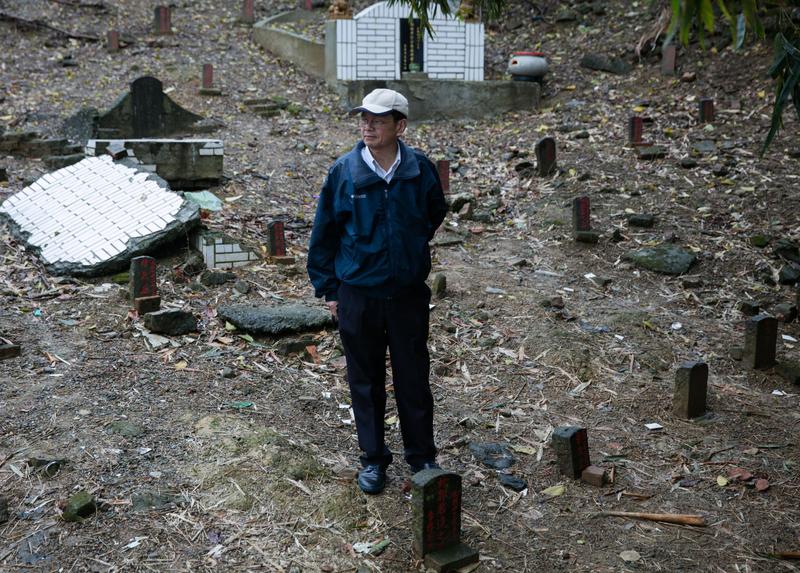
After the Second World War, many youths participated in the conflict surrounding the 228 Massacre. As the ensuing Chinese Civil War reached its most intense period of fighting, anti-KMT sentiment was growing rapidly in Taiwan. Members of the CCP Taiwan Province Working Committee were anxious to "liberate" Taiwan, and collected intelligence on left-leaning intellectuals, teachers, students, workers, and farmers on Taiwan with plans to foment an armed revolution.
To secure their rule, the KMT government declared martial law in 1949. They doubled their efforts in purging their ranks of Communists and conducted a ruthless suppression of rebels, right up until the peak of the White Terror in 1950. Prisoners were executed at gunpoint at Machangding on the banks of the Xindian River. The execution grounds moved in 1954 to Ankeng, now the Xindian District Third Public Cemetery.
Their remains were sent to the Elysium Funeral Parlor, now part of Linsen Park. If no family came forward to claim the remains, they would be buried at the cemetery at Liuzhangli or used as cadavers for medical students at the National Defense Medical Center. In the latter case, the name of that hospital would be written on their urns.
"When we found out there were so many graves over there in 1993, my mother and I were astonished. It's hard to describe that feeling. It's been over 50 years," says Huang Hsin-hua (黃新華), a 65-year old retired teacher whose father was a victim of the White Terror.
"When I first went to see them, it was so painful. Written on a small unremarkable gravestone amongst the weeds was my father's name: Huang Hsien-chong (黃賢忠)."
In 1951, during a government crackdown on political study groups and criminal gangs, many teachers at Yimin High School in Zhongli were arrested, including Huang Hsien-chong and his wife. A year before Hsien-chong was executed at gunpoint in 1952, his wife Yang Huan (楊環) gave birth to their daughter in prison.
"Retrieving his bones was even worse. A typhoon had just struck: fallen trees were everywhere, and the gravestone was buried by mud and rock. We spent three to four hours digging out a deep hole, and just as we were about to give up we finally noticed some fingerbone and skull fragments. Sometimes I think about it and wonder, were those actually my father's bones? I can't be certain, but this is all we have," Huang says of the father she never met.
In 2000 and 2002 the Taipei City government designated the execution grounds at Machangding and the burial grounds at Liuzhangli as memorial parks, but aside from the annual "autumn rite" conducted by victims' associations, the park at Machangding is nothing more than a place to barbeque or ride a bike. Liuzhangli has also returned to its original silence, with only researchers, family or old friends of the deceased visiting in commemoration. Today, more than 60 percent of remains have not been claimed by their families.
Liuzhangli remained outside the public eye until Taipei City Council members Jian Shu-pei (簡舒培) and Lee Chien-chang (李建昌) held a press conference there in 2015, blaming the poor state of the site on a lack of conservation efforts and stressing its historical significance as the only remaining burial ground for White Terror victims. They contrasted this treatment with the nearby gravesite of former Defense Minister Bai Chongxi (白崇禧), which received allocations in the city budget since it was designated a historic site.
"It was a great surprise to concerned organizations and individuals that these two city councilors had raised Liuzhangli," said Lin Chuan-kai (林傳凱), a Ph.D. candidate in the sociology department at National Taiwan University. In 2008, Lin participated in a program directed by Academia Sinica to collect statistics on the number of dead buried at Liuzhangli. They recorded the identities of the victims, collated other available records, and conducted a geological survey. GPS coordinates were even logged for each gravesite. The results were then published on a website, called "Souls Extinguished at Liuzhangli".
"Unlike how 228 has become an important symbol for Taiwanese, for a long time we've felt, that the question of how to regard the dead buried at Liuzhangli during the White Terror is exceptionally difficult because it involves underground CCP operatives in Taiwan from 1940 to 1950," Lin says candidly.
From the end of the martial law period until today, there have been two national level reports on the 228 Massacre, one initiated by President Lee Teng-hui and the other by President Chen Shui-bian. By contrast, there are no government reports on the much longer White Terror period.
"The 228 Incident is a single event, which makes it easier to talk about, it is the starting point for discussing transitional justice, followed by the Kaohsiung Incident and democratization," says Huang Chang-ling (黃長玲), an assistant professor at National Taiwan University.
"On the other hand, the White Terror is a period of time which is difficult to place in a narrative. But its impact on society was very deep. What actually happened in those 38 years? There hasn't been a national accounting of what transpired."
The term "White Terror" can be traced back to the French Revolution, referring to the reprisal operation by right-wing supporters of the House of Bourbon (who wore white) against the left-wing Jacobins. The term was later broadened to describe suppression against left-wing Communists.
In the context of Taiwan, the White Terror generally refers to the martial law period between 1949 and 1987. During this time it was common for civilians to be tried in military courts under charges of "civil unrest" and "foreign aggression." People on both the left and the right were persecuted, and there were many cases of mistaken convictions or fabricated charges. In a general sense, this period continued until 1992 when Article 100 of the Criminal Code (which established life sentences for intent to destroy the state, usurp national land, illegally alter the Constitution, or topple the government) was formally abolished.
The KMT suppression of the left reached its height between 1949 and 1955. For a long time, the term "White Terror" was taboo for government officials, who used the term "martial law period" instead. This taboo was broken in 2008 when the Ministry of the Interior created the White Terror Political Victims Monument on Ketagalan Boulevard.
From mid to late 2015, the discussion surrounding Liuzhangli came to represent the difficulties in facing this particular stretch of Taiwanese history. Immediately after the press conference by the Taipei city councilors, the city government called upon civic groups and members of the cultural assets committee to conduct an on-site survey and assess the possibility of designating the site as a cultural asset.
But the initial finding of the three committee members present, Lee Chian-lang (李乾朗), Lee Bin (李斌) and Chou Chong-hsien (周宗賢), was that the site "did not have cultural value."
According to the committee, the site was too "messy" and it was difficult to find aesthetic value in the crudely-made gravestones, which were difficult to distinguish from those in an ordinary cemetery. The main reason, however, as expressed by a committee member was that "the truths regarding this political incident have not yet been definitively understood or recorded."
The committee report concludes with qualms about drainage at the site, and suggests it is unnecessary to preserve the original form of the graveyard. Instead, the committee notes that remains could be collected in a columbarium supplemented by historical exhibits.
"When I arrived on the site that day, the committee member didn't even know who Huang Rong-can (黃榮燦) was," says Yen Hong-wei (演洪維), "The investigators should at least do a little bit of homework!"
Yen was present during the survey and has family counted among the victims of the White Terror. He is shooting documentaries about both the 228 Massacre and the White Terror period.
Huang Rong-can's woodcut, The Horrifying Inspection, often appears in middle school textbooks in Taiwan. It is considered to be the only work of art that described and protested the 228 Massacre, at the time. Huang was accused by the KMT of participating in a criminal artistic organization and was charged with "disseminating false culture and producing reactionary propaganda." In 1952, he was executed at gunpoint, and is buried in the first section of the memorial park.
"Every soul departed is a family destroyed," says Hung Wei-jian (洪維健), whose parents were sent to jail as political prisoners in the 1950's. At the time, his mother was pregnant, Wei-jian was born in prison and spent the first five years of his life there.
"If my parents weren't lucky, then they would also be laying there in Liuzhangli. Because of these memories, that hill…" At this point, Hung chokes up.
In 2011, Hung and Lee Kun-long — who is also the son of a White Terror victim — were commissioned by the "Compensation Foundation for Victims of Improper Verdicts in the Martial Law Era" to conduct another investigation into the historical artifacts at Liuzhangli. Using detailed reports and archival material, Hung and Lee discovered even more victims and tombstones, and recorded their findings for each case.
When the mass graves at Liuzhangli were discovered in 1993 they received much public attention. In 1998 the Legislative Yuan passed the Martial Law Era Improper Ruling Compensation Bill, which granted families of White Terror victims monetary compensation, to be determined by the Compensation Foundation.
But over the years, the Compensation Foundation's methods have attracted public criticism. Wu Nai-te (吳乃德), a researcher at Academia Sinica who has long advocated for transitional justice, criticizes the committee for "low transparency, inefficient operations, underperformance, and overusing resources."
"Even the Legislature has called these highly paid committee members 'fat cats'", he adds.
Because of public criticism and a lack of support in the Legislature, the Compensation Foundation was dissolved in 2014, and much of the research commissioned was never released to the public, including the investigation at Liuzhangli.
What's more, when confronting the issue at Liuzhangli, the question of how to regard the identities of these victims was a problem that perplexed Taiwanese society. When the compensation bill was first discussed in the Legislature, some felt that the portion of victims who were helping the CCP to take over Taiwan should fall under the normal definition of a "political crime" and not be subject to compensation.
"For a time, the victims were presented as a uniform group, that is as idealistic youths who were arrested for attending study groups, and who were tortured terribly and charged falsely," says Lin Chuan-kai, whose dissertation investigates the workings of the CCP Taiwan Province Working Committee during the White Terror. "But what if some were actually organized and had planned to topple the government? The duality between an evil authority and innocent common folk is the established framework when we talk about transitional justice today."
Other scholars approach the issue from the standpoint of abuse of power, and question whether an illegitimate government ruling through martial law could, in the name of the nation, deprive another group of their lives.
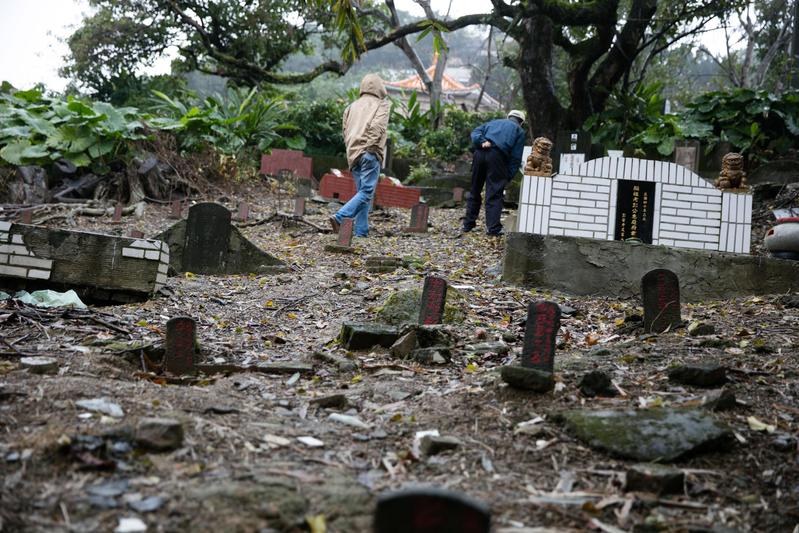
"Against the backdrop of the Cold War in the 50's, the KMT had already monopolized force and consolidated power in Taiwan. Given their relatively safe hold on power, what political legitimacy did they have to conduct these executions?" says Hsueh Hua-yuan (薛化元), a professor of Taiwanese history at Chengchi University.
Under the Cultural Assets Protection Law, a cultural asset should "have historical, cultural, artistic or scientific value." But what kind of value do the scattered graves at Liuzhangli have? The hesitation of the cultural assets committee and their subsequent rejection should not have come as a surprise, as the public did not have access to complete information and there is still controversy surrounding the identities and motivations of the victims.
When the cultural assets committee decided that Liuzhangli did not require conservation, Hung Wei-jian rushed between historians, representatives and city hall advisers to see if there was a possibility that the verdict could be overturned. He was fearful that Liuzhangli could be leveled flat overnight due to society's ignorance and neglect.
His worry was not unfounded. When the Ministry of Finance's National Property Association concluded a survey in July 2015, they issued a statement that fast-tracks use of the area as a public cemetery.
"The city plans to allocate national property at Wuxing subsection 2, parcel 635 and 637 (the location of the third section) for use as a public cemetery. This office does not authorize the use of the aforementioned property by any persons, and existing graves have no right to occupy the site."
Responding to the statement, Hung Wei-jian could hardly conceal his anger: "So, I guess they just decided to bury themselves in this spot?"
This was not the first time such an opinion has been issued. In early 2014, the National Property Administration sent a letter to members of the Mutual Assistance Association for Former Political Prisoners in the Taiwan Area, as well as to Taipei City's mortuary office, declaring that a memorial park constructed in 2003 will not include the three White Terror victim burial ground zones, and that they needed to verify whether the sites occupied national land.
The memorial park was planned during Chen Shui-bian's tenure as mayor of Taipei; but under the Ma Ying-jeou mayoralty, the city took a hands-off approach to the park's administration. At the time, the three burial grounds were viewed as part of the public cemetery, and the mortuary office and Mutual Assistance Association tacitly agreed to jointly administer the land.
Aside from exposing how out-of-touch the national government was, the National Property Administration's letter demonstrated the marginal status of the Liuzhangli gravesites. Having been stripped of life by the nation half a century ago, the dead are not just forgotten but seen as "occupying" national land.
In contrast to public figures who work actively to spread the word and make connections in order to consolidate public consensus, the Mutual Assistance Association declined to comment on the attitudes of the cultural assets committee, saying only that they "wished to preserve the original form of history."
Although it was the Mutual Assistance Association that discovered the site, the group itself is not without controversy. They embrace the idea of sacrifice and devotion to a red motherland; "We do not actually care too much about whether it is classified as a cultural asset. We hope that after unification, we can consult the opinions of our elders and exact a glorious punishment," says Association president Tsai Yu-rong (蔡裕榮).
This kind of pro-unification viewpoint is displayed in full on the opposing couplets hanging at the "People's Loyal Spirit" (人民忠魂) monument in the memorial park:
"Let us walk towards an unfulfilled aspiration of wealth and power via democratic unification; to love the country and the homeland and transform society until the day we die."
The dead cannot speak, and the living sing the praises of heroes' sacrifice. Whether or not these represent the ideals of the victims from the '50s is a difficult question for present-day Taiwanese society to understand, a consequence of the distance that grows with each passing day.
"In December of 2013, we organized an activity to commemorate the 20th year anniversary of the discovery of the Liuzhangli graves. That day there were more there 300 people who came, but there was not a single reporter from the media" says Tsai.
But there are some young people who help the Mutual Aid Association plan exhibitions, do work, and give tours, and try to jettison the discussion of unification. For example, the exhibit "Red Group" (紅字團, 2014-1949) at Taipei's Treasure Hill Artist Village placed Liuzhangli in the context of the Chinese Civil War and the Cold War in an attempt to incite a more open-minded discussion and to present a more multifaceted meaning behind the graves.
In 2015, under the pressure of various civic groups, the Taipei cultural assets committee opened their doors for a public meeting for the first time. The graveyards at Liuzhangli, which were determined to lack cultural value, were a focal point of the meeting.
Facing the hesitation of committee members who indicated that studies were still pending, Tsai Kuan-yu (蔡寬裕), director general of the "Formosan Political Prisoners Association" — an organization with links to the DPP that advocates for greater restitution for victims of political crimes — angrily accused specialists of arrogance and laziness, and of ignoring historical facts.
In the end, the committee took the unprecedented step of foregoing a committee conference and instead took an anonymous vote to decide the status of Liuzhangli. More than two thirds of the members voted to designate the site as a cultural landscape under the Cultural Assets Law to "commemorate the significance of its history."
Though the committee was flexible in classifying Liuzhangli as a cultural landscape, the technical question of how to conserve the site is the greatest challenge for the future. "
Because the site is located on a steep hill, when the storms come, the stones will be washed away and there is a constant danger of a landslide," says Lee Chian-lang, who made the initial decision not to protect the site. "We would have to reinforce the soil and build drainages. Furthermore, since ordinary gravesites have mixed with historical ones over the years, we would need a team of specialists to conduct a study to clarify which tombstones are relevant and which are not."
After it was classified as a cultural landscape, the Taipei City Department of Cultural Affairs conducted a public hearing to discuss the scope of conservation at Liuzhangli and how to manage it.
For the dead, this controversy over cultural asset classification is just an insignificant footnote on a long and lonely journey. But for the living, it is an opportunity to create a greater understanding.
"Every time I come here and see the names on the tombstones and think about how they moved from life to death, I feel sorrow. There is a lot of human nature here which is hard to work into a single narrative of 'human rights victims' or 'revolutionary martyrs'", says Lin Chuan-kai.
He gives the example of a Mr. Lee, a young man arrested for political activities, who then turned in others to ensure his freedom.
"Mr. Lee was a young carpenter from Taichung who was a liaison for an underground political party. After his arrest he told the special agent that he missed his mother and hoped to turn over a new leaf. He gave them information that helped arrest other party members, but in the end he was executed along with them and carried his guilt to the grave in Liuzhangli. Mr. Lee was arrested and also helped to arrest others. His motives were driven by his yearning to live and his love for his family. Every time I see these impossible choices caused by extreme politics, I can't help but think, if it were me, what would I have chosen? Could I really have passed that kind of test?"
Having been cruelly executed and tossed away, discovered and then forgotten, these modest burial mounds on the slopes of Liuzhangli fade away from time to time, only to flash back into view. They remind us of the inescapable shadow cast over the short but complicated history of this land.
(To read the Chinese version of this article, please click: 歷史迷霧中的六張犂──白色恐怖時期亂葬崗保存爭議)
深度求真 眾聲同行
獨立的精神,是自由思想的條件。獨立的媒體,才能守護公共領域,讓自由的討論和真相浮現。
在艱困的媒體環境,《報導者》堅持以非營利組織的模式投入公共領域的調查與深度報導。我們透過讀者的贊助支持來營運,不仰賴商業廣告置入,在獨立自主的前提下,穿梭在各項重要公共議題中。
今年是《報導者》成立十週年,請支持我們持續追蹤國內外新聞事件的真相,度過下一個十年的挑戰。

